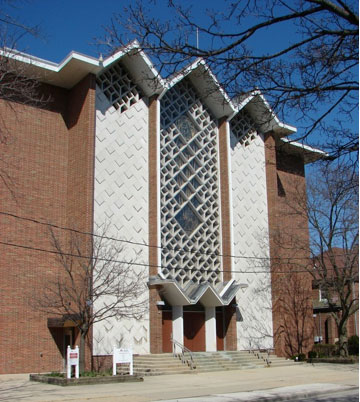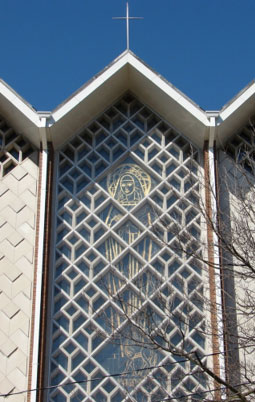63. St. Agnes Catholic, 1960
Now All Saints Catholic
4051 North 25th Street (north of Capitol Drive)
Architects: Herbst, Jacoby and Herbst

St. Agnes Parish, established in 1925, was one of several new Catholic parishes formed in response to the city’s rapid growth in the 1920s. The parish constructed a combined church and school building on the property in 1926, which still stands to the north of the present church. Before a separate church building could be erected, the stock market crash of 1929 forced the parish to set aside any plans for new construction. It would be another two decades, following the Great Depression and World War II, before the parish was finally able to commence with the construction of a new church.
Plans for a church were drawn up in the late 1940s by William Herbst and Associates. Only the basement was built initially, with the parish planning to use the basement meeting hall as a temporary church until its finances improved sufficiently to allow construction of the aboveground church. The basement church was completed and dedicated in July of 1949. Although it was larger than the hall in the 1926 building that had previously been used for church services, the basement church was not very attractive aesthetically. The flat-roofed building extended several feet (less than a full story) above the ground, with small windows just above ground level. Temporary wooden buildings resembling tool sheds enclosed stairways leading down into the church. As with the combined church and school built in the 1920s, the parish used the 1949 basement church for a longer period than anticipated.
By the late 1950s, St. Agnes Parish was ready to build its aboveground church. However, the parish had grown to such an extent by this time that it needed a larger church than the one designed ten years earlier. Plans for a new church were prepared by the firm of Herbst, Jacoby and Herbst, the successor firm to William Herbst and Associates. The three partners were William Herbst, John Jacoby (1912-2003) and Roger Herbst (1917-2003). John Jacoby began working for Herbst and Kuenzli (predecessor to William Herbst and Associates) in the early 1930s, rising from draftsman to partner by the mid-1950s. William’s son, Roger Herbst, studied civil engineering at Marquette University and architecture at Cornell University, graduating in 1941. He entered his father’s firm shortly after World War II, and was the primary designer for the St. Agnes Church commission. Herbst, Jacoby and Herbst were responsible for nine Catholic churches built in Milwaukee from the mid-1950s to 1970, in addition to at least three by predecessor firms led by William Herbst.
Following 18 months of construction, the new church for St. Agnes Parish was dedicated in November of 1961. It shows the influence of the New Formalism, a sub-style or genre of modern architecture popular from the late 1950s through the 1960s but not often used for ecclesiastical buildings. New Formalist designs were in part a reaction to the plain and severe appearance of much modern architecture, and exhibit more ornamented exteriors than other modern buildings of the period. Instead of using applied ornament in the traditional manner, New Formalist buildings are embellished with patterns created by the arrangement of structural materials or by lacy sunscreens of metal or perforated concrete block. They also typically have simple rectangular forms and symmetrical facades, often adorned with colonnades or arcades.
At St. Agnes, the symmetrical facades have vertical bands of white cast stone topped by small gables. Cast stone is a form of concrete in which the individual precast components have a smoother and more uniform surface than typical poured concrete, resembling that of cut stone. The solid cast stone pieces are assembled here to form a pattern of slightly raised diamond shapes. At the top of each band, cast-stone components in the form of diamonds and Y-shapes form open grilles in front of diamond-shaped windows. The central portion of the east façade, above the main entrance, is also covered in this open grillework, behind which is a large stained glass window depicting St. Agnes. This window is 17 feet wide by 50 feet in height.
Several of Milwaukee’s Catholic parishes were consolidated in the early 1990s, due to declining membership and a shortage of priests. St. Agnes Parish combined with the nearby parishes of St. Leo and Holy Angels, with the consolidated parish renamed All Saints. Services at All Saints are now conducted entirely at the former St. Agnes Church.
Sources:
“Archbishop Will Dedicate St. Agnes,” Milwaukee Sentinel, November 11, 1961, part 1, page 8, column 1.
Herbst, Jacoby and Herbst, architects. Biographical file, Wisconsin Architectural Archive, Milwaukee Central Library.
Herbst, Jacoby and Herbst, architects. Drawings for Construction of St. Agnes Catholic Church, dated February 15, 1960. Wisconsin Architectural Archive, Milwaukee Central Library, drawing set 258-183.
Herbst, William and Associates, architects. Drawings for construction of St. Agnes Catholic Church, dated May 10, 1948. Wisconsin Architectural Archive, Milwaukee Central Library, drawing set 13-69.
“Jacoby, John P., FAIA” (obituary), Milwaukee Journal-Sentinel, March 11, 2003, page 4B, column 4.
“New St. Agnes Church – Victory for Patience,” Milwaukee Sentinel, part 1, page 9, column 5.
St. Agnes Parish, Golden Jubilee, 1925-1975. St. Agnes Parish, 1975.
The Story of St. Agnes Church, Milwaukee, Wisconsin. Pamphlet published by St. Agnes Church, undated.

